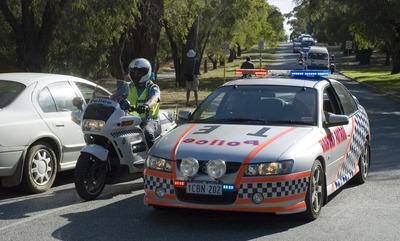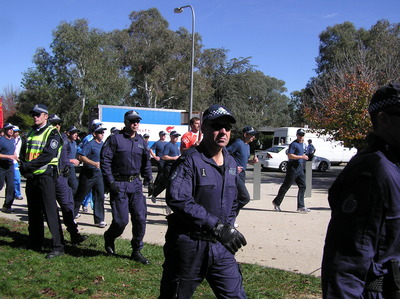Mobile broadband for public safety
The Australian emergency services sector is pushing the federal government to set aside spectrum for public safety mobile broadband.
When it comes to spectrum allocation for mobile broadband, which entities should take priority - commercial carriers (who pay big bucks to government for spectrum rights) or agencies that provide essential public services (who can’t, and many would say shouldn’t, match what the carriers pay)? How can the needs of both user groups be met?
At the recent ACMA Radcomms 2013 conference in Sydney, Mark Burgess, CEO of the Police Federation of Australia, forcefully argued the case for public safety agencies to be allocated a fair share of spectrum for mobile broadband public safety communications - such as the unsold portion of 700 MHz digital dividend spectrum.
The following is an edited version of Burgess’s presentation.

*************
In 2011, when giving evidence to a US Senate Committee on broadband spectrum for public safety, New York Police Commissioner Ray Kelly told the committee that a 16-year-old with a smartphone has a more advanced communications capability than a police officer carrying a two-way radio.
In Australia there are around 400,000 first responders across our public safety agencies. Our roles are unique. When society and nature are at their worst, police and emergency services need to be at their best.
We believe our governments have an obligation to emergency services personnel to provide them with the best equipment and resources that will enable them to do their job effectively and efficiently, and to protect the public and each other. A mobile broadband capability fits into that category.
Deloitte Access Economics, in a June 2013 report, ‘Building our Nation’s Resilience to Natural Disasters’, said: “… mobile broadband would achieve a more timely assessment of incidents, more effective command, control and coordination of activities, faster and more appropriate response to incidents that will lead to a more productive use of resources and improved personal safety”.
The legislation
When the Keating government embarked on radical market-based reform of spectrum allocation in 1992, it foresaw that a problem would arise, namely how to ensure that non-commercial users like police and emergency services had affordable access to spectrum into the future. Recognising that these not-for-profit public safety agencies could not compete in an open market system against the big telecommunications companies for a rare commodity, the government built a series of safeguards into the Radiocommunications Act 1992.
The Act specifies that the system must make adequate provision of spectrum for law enforcement and emergency services. Parliament was saying that spectrum has a public safety value, not just a value for commercial uses.
Charging for spectrum must also take into account the value of non-commercial use of spectrum. In other words, the public safety agencies should not be expected to pay the commercial rate for their spectrum - the Act provided for spectrum to be reserved for these essential public purposes so that they would not have to compete at auction.
These safeguards need to be upheld today more than ever, as the big telcos vie for spectrum at the expense of public safety and the public interest.
It is the responsibility of the government and ACMA, under the Act, to ensure that the spectrum needs of law enforcement and emergency services are directly met and not to send these public safety agencies to do the best deal they can with one or more of the major telecommunications companies at commercial rates.
Factors in valuing the spectrum
The Deloitte Access Economics report indicated that the total economic cost of natural disasters in Australia averages $6.3 billion per year, and that this is expected to double by 2030, and to reach approximately $25 billion by 2050. Of the costs of disasters to governments, 80% falls to the federal government. Currently Australia spends $1 on pre-disaster measures and $10 on post-disaster recovery. Motorola Solutions told the 2013 Parliamentary committee on spectrum for public safety, that “every dollar spent on public safety returns $5 to the community”.
Deloitte Access Economics also says a simple cost-benefit analysis shows how government funds would be saved by bringing forward investments in pre-disaster resilience measures. It would come as no surprise that we consider spectrum for public safety to be such a resilience measure.
Our view is that ACMA should take a whole-of-government approach when making spectrum decisions. This means taking into account these real costs to the federal government.

Public safety mobile broadband
There is currently an argument about the need for a dedicated public safety mobile broadband network. We suggest that this argument has been had and resolved.
Two recent parliamentary enquiries have come to a unanimous and bipartisan view that a dedicated public safety mobile broadband network is the way forward.
In 2011 a Senate Committee inquired into the capacity of communications networks and emergency warning systems to deal with emergencies and natural disasters. The committee recommended the Commonwealth Government allocate sufficient spectrum for dedicated broadband public protection and disaster relief (PPDR) radio communications in Australia.
In 2013 the Parliamentary Joint Committee on Law Enforcement conducted an Inquiry into Spectrum for Public Safety Mobile Broadband. That Committee had as its chair the former Attorney-General, Robert McClelland, who had also previously been Minister for Emergency Management. The deputy chair was Senator Fiona Nash, Deputy Leader of the National in the Senate and now Assistant Minister for Health. Other members were Senator Stephen Parry, Deputy President of the Senate and Michael Keenan, then Shadow Minister for Justice and now Minister for Justice who now also has responsibility for Emergency Management. It was not a lightweight committee.
The committee made five key recommendations, including that a minimum of 20 MHz should be allocated to public safety in either the 700 or 800 MHz band.
What brought them to that conclusion? When the committee did the analysis between a potential carrier model for public safety and a dedicated public safety network, there was only one conclusion they could come to. Consider the following points:
- A public safety network has to be able to deal with a variety of incidents, from day-to-day operations, right through to those mission-critical events such as natural disasters, major incidents and even terrorist strikes.
- The carriers’ model is built on revenue growth and profits for shareholders, whereas the public safety model is built on the premise of protecting life and property.
- The carrier’s model is designed for normal day-to-day operations. Their networks can quickly be degraded with traffic overload, whereas public safety is built on my earlier premise - when society and nature are at their worst, public safety systems need to be at their best.
- The carrier’s model is built on one-to-one communications; public safety is one to many.
- The carrier’s model is based primarily on heavy downloads whereas public safety will rely on heavy uploads.
- The carrier’s network is built to a commercial grade while public safety needs to be mission critical hardened.
- The carriers do not need to have the security considerations that public safety requires.
A further consideration is ownership - what if the carrier were owned by a foreign government? What would be the implications for the security of the network?
A new government
Did the federal election change anything? We think not. If anything we think it’s enhanced our prospect of getting a public safety network developed.
In the lead-up to the 2013 federal election, we posed the following question to the major political parties: “The PFA seeks your party’s commitment to provide a minimum of 20 MHz of the 700 or 800 MHz band spectrum for a dedicated mobile broadband network for Australia’s public safety agencies so that inter-operable communications become a reality across the nation.”
The Coalition gave a fairly detailed response, but the key point was: “If elected, a Coalition Government will conduct a rigorous cost-benefit analysis into the question of emergency services wireless communications and consider the most cost effective means of upgrading Australia’s law enforcement and emergency services mobile broadband network. The Coalition will continue to carefully investigate this issue and seek to weigh the various competing public interests in consultation with stakeholders and State and Territory Governments.”
We welcome the Coalition Government’s commitment to conduct a rigorous cost-benefit analysis. We think that will play significantly in favour of public safety agencies.

The cost-benefit research conducted by Deloitte Access Economics and others will be interesting reading for the new minister.
A May 2013 report by Professor John Ure from the University of Hong Kong, titled ‘A Study of Value and Opportunity Cost in the Assignment of Radio Spectrum’, researched eight economies in the Asia-Pacific region - Australia, China, Indonesia, Malaysia, New Zealand, Singapore, South Korea and Thailand.
His policy findings are:
- On a social cost-benefit basis the benefits of assigning broadband spectrum to dedicated PPDR services on an exclusive basis far outweigh the costs as measured by opportunity cost.
- There is justification on a cost-benefit basis for allocating the spectrum that is considered sufficient for national needs. In all cases the cost-benefit analysis seems to support a case for up to 20 MHz and, in every case except Singapore, up to 30 MHz if necessary.
- The decision would need to be based upon a realistic assessment in each country of what contribution broadband would make to reducing the risk of loss.
- On a cost-benefit basis the opportunity cost is insufficient to justify market-based assignments of spectrum for PPDR purposes.
What this means is that on a cost-benefit basis, it is better to allocate 20 to 30 MHz of spectrum for public safety than to auction it to commercial carriers to achieve additional funds for the Federal Budget.
The Police Federation's position
As a result of our work, and that of many others, we’ve come to a number of conclusions.
First, public safety needs mobile broadband communications. It is in the public interest. This must be a dedicated network controlled by public safety because our needs are so different from those of commercial networks.
Secondly, there is a shared responsibility between the Commonwealth Government and state and territory governments for emergency management. The federal government has the spectrum; the states are prepared to invest in the development of the networks.
And remember, the states are not starting with a blank piece of paper as many seem to suggest - they already have significant physical infrastructure that they would be enhancing. (Ericsson, in its submission to the 2013 Parliamentary Inquiry, revealed that the construction of physical infrastructure by way of towers and sites - which many of the public safety agencies already have - represents 80% of overall network costs, compared to the 20% cost of equipment.) And the federal government will need access to the state networks for mission-critical incidents and major events like G20.
Thirdly, there are serious doubts about the feasibility of public safety agencies roaming or overflowing onto public networks during critical incidents. While a report on this aspect is due on this shortly, many people have advised us that technically it’s possible but there would be serious flaws in such a system. Flaws that could jeopardise the safety of emergency services workers and the public. It is a risk, unless we can be guaranteed otherwise, that we think is too great to take.
The possibility of commercial carriers or the NBN accessing the public safety network when it is not in high demand should be seriously considered as a way of ensuring efficient use of spectrum. The caveat is that the public safety agencies must have control of decisions about spectrum sharing.
What we don’t have agreement on yet is the amount of spectrum public safety needs, although the Joint Committee concluded that a minimum of 20 MHz is necessary and it will come as no surprise that we agree.
When a final decision is made and everyone has locked himself or herself into a position, I hope we’ll have got it right. When we have the next Royal Commission, Commission of Inquiry or even a Coronial Inquiry into a natural disaster or some other major critical incident - and we will - this issue and the decisions that were made will be under the microscope. If we’re judged to have got it wrong, whoever is in the witness box at the inquiry will be in the loneliest place in the world trying to justify their decisions.
Mark Burgess will take part in ‘Workshop 3 - Mobile broadband & LTE for critical communications’ at the Comms Connect 2013 conference in Melbourne in November.
2025–26 Thought Leaders: Tim Karamitos
Tim Karamitos from Ericsson discusses the connectivity requirements of emergency services and...
2025–26 Thought Leaders: Ruth Tovo
Comms Connect panellist Ruth Tovo, from the South Australian SES, discusses the technical...
ARCIA update: celebrating excellence in our industry
The ARCIA Annual Gala Dinner and Excellence Awards took place during the same week as Comms...




